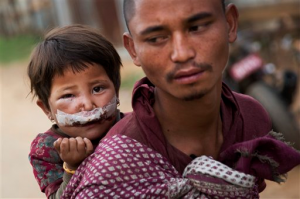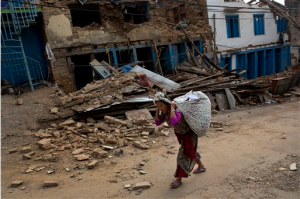
Many survivors of Nepal’s most recent earthquake remain cut off by blocked roads in isolated villages, a U.N. official said Wednesday, after this Himalayan nation suffered through its second major quake in less than three weeks.
The magnitude-7.3 earthquake shook the impoverished country Tuesday, killing at least 79 people and injuring more than 2,300, just as it was beginning to rebuild from a devastating April 25 earthquake.
The most recent quake hit hardest in deeply rural parts of the Himalayan foothills, hammering many villages reached only by hiking trails and causing road-blocking landslides.
“Damaged houses were further damaged or destroyed. Houses and schools building spared before were affected yesterday, roads were damaged,” said Jamie McGoldrick, a top U.N. official in Nepal.
Among 14 quake-hit districts, some are barely accessible, and a large part of the affected population could not be reached easily because of damaged roads.
“Some are even difficult to reach by helicopter. We are facing monumental challenges here to support the government in these districts to have a credible response,” McGoldrick said.
On Wednesday, officials with bullhorns walked through the worst-damaged streets of Chautara, a small town northeast of Kathmandu, calling for people to leave buildings in danger of collapsing after Tuesday’s quake.
“There is danger!” they said over the bullhorns. “Leave the buildings!”
Most people, though, had fled into the open the day before and had spent the night in tents or under plastic tarps.
Chautara, a foothills town, became a hub for rescuers and humanitarian aid after the first earthquake. Officials there said at least three people had died and more than 60 were injured in the new quake.
People salvaged whatever they could from their toppled homes. Most houses appeared to be damaged; some were leveled. Others tilted and rested on adjacent homes.
“We were in the shop. All of a sudden the building shook. I jumped out of the store and the next second it fell down. It was already tilted by the last month’s earthquake. I watched it just slide and fall on its side,” said Devi Acharya, a convenience store owner.

Meanwhile, a U.S. Marine Corps helicopter carrying six Marines and two Nepalese soldiers remained missing. It had been delivering disaster aid Tuesday in the country’s northeast, U.S. officials said. There have been no indications the aircraft crashed.
Home ministry official Laxmi Dhakal said Wednesday that army helicopters were scouring the Sunkhani area, nearly 80 kilometers (50 miles) northeast of Kathmandu, for the missing helicopter.
Most of the people confirmed dead in the second quake by Wednesday afternoon were in Dolakha district, northeast of Kathmandu, said the district’s chief administrator, Prem Lal Lamichane.
“People are terrorized. Everyone is scared here. They spent the night out in the open,” Lamichane said, adding the administration was running out of relief materials.
He asked the government to send more helicopters and supplies and said many injured people were stranded in villages.
Tuesday’s quake killed 16 people in northern India and one person in Tibet.
The magnitude-7.8 earthquake that hit April 25 killed more than 8,150 people and flattened entire villages, leaving hundreds of thousands homeless in the country’s worst quake since 1934.
The U.S. Geological Survey said Tuesday’s earthquake was the largest aftershock of the April quake. But it was significantly less powerful and occurred deeper in the Earth. Working from USGS data, calculations done by University of Michigan earthquake geophysicist Eric Hetland indicated that about 65,000 people were exposed to “violent” shaking Tuesday, compared to 1.5 million on April 25.
The first quake also drove many people to leave damaged homes, which were empty when the new quake caused more damage and collapses.
On Wednesday, McGoldrick said the U.N. revised its donor appeal to provide $423 million. The response to the earlier appeal of $415 million has been low, with about 15 percent of the sum received.




